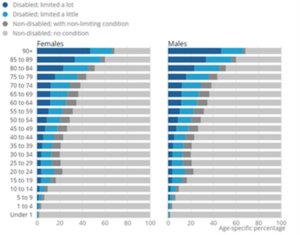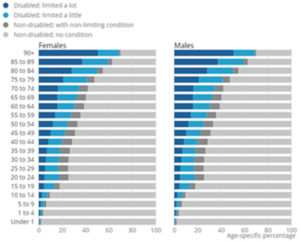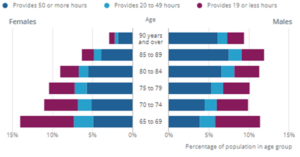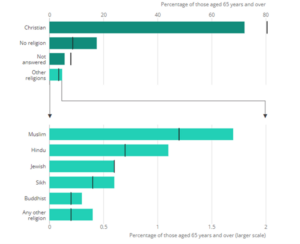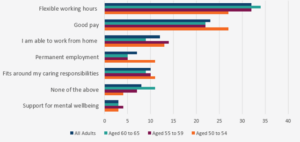Dear Ms Nokes,
I write in response to the Women and Equalities Select Committee’s call for evidence for their inquiry into the “Impact of the rising cost of living on women”.
As the Committee is aware, the Office for National Statistics (ONS) is the
largest producer of official statistics in the UK. We aim to provide a firm evidence base for sound decisions and develop the role of official statistics in democratic debate. As the UK’s National Statistical Institute, the ONS produces a wide range of economic and social statistics, including the latest data and trends about the cost of living and how this is affecting people in the UK.
Since UK consumer price inflation peaked in October 2022, the cost of living in the UK has been fluctuating. To assist the Committee in understanding how these changes have impacted women, we have prepared a written evidence submission that provides a broad overview of the major after-effects of changes to the cost of living in the UK. This includes looking at the main drivers of rising inflation, food and beverage costs, energy costs, rental prices, among others.
This submission also details how data collected in the Opinions and Lifestyle Survey shows women are more likely than men to report difficulties in paying their energy bills and the unlikelihood that they will be able to save money in the future. Alongside this, we have provided analysis of the regional and national differences in how the cost of living has changed in recent months, as well as specifically looking at how those from the lowest income households have felt the effects.
Changing cost of living
UK consumer price inflation (the rate at which prices faced by consumers change) began accelerating in Spring 2021 and peaked to a 40-year high of 9.6% in October 2022. Although rates are now falling, they have remained high in the year since. In the year to September 2023 the Consumer Prices Index including owner occupiers’ housing costs (CPIH)was 6.3%, the lowest rate since March 2022.
The main drivers of rising inflation over the last two years have included food and non-alcoholic beverages, housing and household services (including rental costs and household energy costs), and transport (including fuel costs).
For food and non-alcoholic beverages, the annual inflation rate to peaked at 19.2% in March 2023, the highest rate in over 45 years. Since then, the annual rate has eased for six consecutive months. Food and non-alcoholic beverage prices showed the first month-on-month price reduction in September 2023.
Annual inflation for motor fuels has been negative since March 2023 reflecting the fall in fuel prices from a peak last year, but the drag on headline inflation has eased as fuel prices levelled off and then started to pick up. The price of motor fuels fell by 9.7% in the year to September 2023, compared with a fall of 16.4% in the year to August, reflecting falling petrol and diesel prices over the last year.
Gas and electricity prices rose at 1.7% and 6.7% respectively in the year to September 2023. Between June and July 2023, gas prices fell at record rates of 25.2%. This was largely because of the lowering of the Office of Gas and Electricity Markets (Ofgem) price cap in that month.
Private rental prices paid by tenants in the UK have risen by 5.7% in the 12 months to September 2023. Recent analysis showed that private renters on a median household income could expect to spend 26% of their income on a median-priced rented home in England, compared with 23% in Wales and 25% in Northern Ireland, in the FYE 2022. Comparatively, housing purchasing affordability analysis has shown a clear pattern of house prices increasing faster than incomes and UK inflation. In the FYE 2022, for homes in England, average house price to household income ratio was 8.4 (meaning 8.4 years of median income to afford median house price) compared to 6.4 in Wales, 5.3 in Scotland and 5.1 in Northern Ireland.
The annual growth for regular pay (excluding bonuses) was 7.8% in June to August 2023, according to the latest earnings data. This is similar to recent periods and one of the highest annual growth rates since comparable records began in 2001. In real terms (adjusted for inflation), regular pay rose by 1.1% on the year.
The gender pay gap, measured using the Annual Survey of Hours and Earnings (ASHE), has been declining over time, and in April 2023 stood at 7.7%. The gap for full time employees is larger for those aged over 40, and for skilled trades occupations (15%) followed by process plant and machine operatives (14.3%). The gender pay gap is higher in all English regions than in Scotland (1.7%), Wales (5.6%) or Northern Ireland (negative 3.5%).
Insights from the Opinions and Lifestyle Survey
The ONS has published a variety of analysis on the impact of the rising cost of living across a range of personal characteristics including sex.
Most recently, the latest article in the roughly quarterly series, Impact of increased cost of living on adults across Great Britain, provided information from the ONS’s Opinions and Lifestyle Survey (OPN) during the period February to May 2023. The article detailed the proportion of adults in Great Britain reporting an increase in their cost of living, the actions they are taking as a result, or the proportion of adults experiencing difficulty affording household expenses (such as energy, rent or mortgage payments or food), by personal characteristics including sex, (see tables 1.1, 2.1, 3.1 and 4.1), household size (tables 1.12, 2.12, 3.12 and 4.12), parental status (tables 1.11, 2.11, 3.11 and 4.11) or region (tables 1.3, 2.3, 3.3 and 4.3).
Estimates in these tables show for example, that women (50%) appear more likely to report it was difficult (very or somewhat) to afford their energy payments than men (45%) and appeared less likely to report thinking they will be able to save in the next 12 months (36% among women, 44% among men).
Considering impacts on other groups of the population likely of interest to the committee, these estimates also show that whilst around 1 in 20 (5%) adults reported that in the past two weeks they had ran out of food and had been unable to afford more, this proportion appeared higher among groups including those; receiving support from charities (45%), living in a household with one adult only and at least one child (28%), receiving some form of benefits or financial support (21%), Mixed or Multiple ethnicity adults (14%), Black, African, Caribbean or Black British adults (13%), renters (14%) and disabled adults (9%).
Looking at regional differences amongst people with these and other characteristics has not been examined using this data source due to sample sizes being too small at this level of geography.
Regional and national differences
The ONS has published a variety of subnational statistics that reflect the geographic differences and the impact of the changing cost of living. Subnational data on this topic has largely focussed on housing, energy insecurity and food insecurity.
The latest article on private housing rental prices showed that prices paid by tenants has varied by English region and UK nation. Private rental prices in Northern Ireland increased by 9.3% in the 12 months to July 2023. This is higher than for other UK countries during the same period when prices rose by 5.2% in England, 6.5% in Wales and 5.7% in Scotland.
In the 12 months to September 2023, private rental prices rose by 5.6% in England, 6.9% in Wales and 6.0% in Scotland. Amongst the English regions, London’s annual rent price inflation was 6.2% in the 12 months to September 2023. This was the highest annual increase across the English regions. This was followed by the West Midlands where annual rent inflation (5.7%) was also above the England average annual rise (5.6%). The North East had the lowest annual increase at 4.7% during the same time period.
The ONS has also published recent analysis on monthly repayments for newly issued mortgages over the past year, because of rising interest rates increasing the cost of borrowing. The analysis is based on some key trends from our mortgage repayments calculator tool and includes variation across English regions and UK nations. Although mortgage rates differ, depending on the size of the loan relative to the value of the property being purchased, house price differences between regions has meant that increases to monthly mortgage payments have varied. In particular, London’s higher house prices have resulted in the largest monthly cost increases. Conversely, Northern Ireland’s lower house prices have resulted in the smallest nominal increases to monthly repayments.
In February 2023, the ONS published analysis on the characteristics of adults experiencing energy food insecurity in Great Britain. Adults in the North East, the East of England, and the North West were all more likely to report that they had experienced food insecurity than those living in London. The analysis also showed that there was no geographic difference between adults reporting some form of energy insecurity.
Impact on lowest income households
Between the FYE 2021 and FYE 2022, median household disposable income for the poorest fifth of the population decreased by 3.8% to £14,500; compared to 1.6% increase for richest fifth. The largest contribution to change in disposable income across all households is attributable to original income, driven by a decrease of 4.0% in the poorest fifth of people, compared with an increase of 5.4% in the richest fifth of people.
More specifically, the poorest fifth of people saw a 7.5% decrease in wages and salaries, while the richest fifth saw a 7.8% increase, and a UK wide increase of 3.2%. For the poorest fifth of people, income was further reduced by a real-term reduction in cash benefits of 2.6% (a nominal £80 increase) between FYE 2021 and FYE 2022, which was not fully offset by a reduction in taxes.
Table 1 shows the equivalised (accounting for household composition) household disposable incomes for some groups, as published within the Effects of Taxes and Benefits release. For non-retired one adult households (without children), where the household reference person was a woman, the mean household disposable income was significantly below the UK average. The disposable household income for non-retired one adult households with children was significantly below the mean UK average, however this group is not routinely split by sex of the household reference person. For retired one adult households (both with and without children), where the household reference person was a woman, the mean household disposable income was significantly below the UK average.
Table 1: Annual equivalised (accounting for household composition) household disposable income by household composition, UK, Financial Year Ending 2022
| Equivalised Household disposable Income (£) | ||||
|---|---|---|---|---|
| UK Mean | One adult household (all) | One adult household (women) | One adult household (men) | |
| Non-retired Households (with and without children) | 41,200 | |||
| Non-retired households (without children) | 39,500 | 36,500 | 41,800 | |
| Non-retired households (with children) | 23,100 | |||
| Retired households (with and without children) | 30,900 | 26,700 | 25,000 | 30,100 |
When comparing spending by the poorest fifth to the richest fifth for FYE 2022, the richest fifth of households’ total weekly expenditure was more than twice that of the poorest fifth of households (£811.20 and £329.80, respectively) . In comparison, mean household disposable income was six times greater in the richest fifth of households than the poorest fifth. The poorest fifth of households continued to spend the greatest proportion of their total expenditure (25%) on housing (net), fuel and power. This is largely because of spending on actual rentals for housing (24% of their total expenditure). Note, housing (net) does not include mortgage payments, this is because mortgage capital payments are not regarded as a consumable item in line and instead add to personal wealth, while interest payments are classified as “other” expenditure, in line with international standards.
We hope this provides some interesting insights for you and the rest of the Committee. Please do not hesitate to let us know if we can provide anything further.
Yours sincerely,
Mike Keoghan
Deputy National Statistician for Economic, Social and Environmental Statistics

